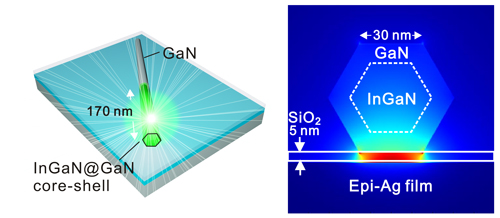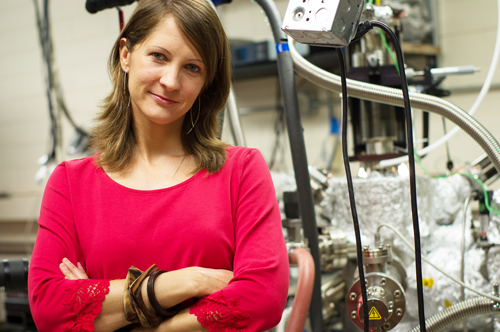The breakthrough could lead to the development of photonic technologies in computing and medicine that are faster and smaller than current electronics.
 Illustration of the nanoscale semiconductor structure used for demonstrating the ultralow-threshold nanolaser. A single nanorod is placed on a thin silver film (28 nm thick). The resonant electromagnetic field is concentrated at the 5-nm-thick silicon dioxide gap layer sandwiched by the semiconductor nanorod and the atomically smooth silver film.AUSTIN, Texas — Physicists at The University of Texas at Austin, in collaboration with colleagues in Taiwan and China, have developed the world’s smallest semiconductor laser, a breakthrough for emerging photonic technology with applications from computing to medicine.
Illustration of the nanoscale semiconductor structure used for demonstrating the ultralow-threshold nanolaser. A single nanorod is placed on a thin silver film (28 nm thick). The resonant electromagnetic field is concentrated at the 5-nm-thick silicon dioxide gap layer sandwiched by the semiconductor nanorod and the atomically smooth silver film.AUSTIN, Texas — Physicists at The University of Texas at Austin, in collaboration with colleagues in Taiwan and China, have developed the world’s smallest semiconductor laser, a breakthrough for emerging photonic technology with applications from computing to medicine.
The scientists report their efforts in this week’s Science.
Miniaturization of semiconductor lasers is key for the development of faster, smaller and lower energy photon-based technologies, such as ultrafast computer chips; highly sensitive biosensors for detecting, treating and studying disease; and next-generation communication technologies.
Such photonic devices could use nanolasers to generate optical signals and transmit information, and have the potential to replace electronic circuits. But the size and performance of photonic devices have been restricted by what’s known as the three-dimensional optical diffraction limit.
“We have developed a nanolaser device that operates well below the 3-D diffraction limit,” said Chih-Kang “Ken” Shih, professor of physics at The University of Texas at Austin. “We believe our research could have a large impact on nanoscale technologies.”
In the current paper, Shih and his colleagues report the first operation of a continuous-wave, low-threshold laser below the 3-D diffraction limit. When fired, the nanolaser emits a green light. The laser is too small to be visible to the naked eye.
The device is constructed of a gallium nitride nanorod that is partially filled with indium gallium nitride. Both alloys are semiconductors used commonly in LEDs. The nanorod is placed on top of a thin insulating layer of silicon that in turn covers a layer of silver film that is smooth at the atomic level.
It’s a material that the Shih lab has been perfecting for more than 15 years. That “atomic smoothness” is key to building photonic devices that don’t scatter and lose plasmons, which are waves of electrons that can be used to move large amounts of data.
 Physics graduate student Charlotte Sanders' research with Professor Ken Shih helped develop the world's smallest nanolaser. She stands here with a molecular beam epitaxy (MBE) machine that she designed and built in collaboration with the Department of Physics Machine Shop and with assistance from co-author Dr. Jisun Kim. The machine is used to create a smooth silver thin film critical to the function of the laser. Photo by Alex Wang.
Physics graduate student Charlotte Sanders' research with Professor Ken Shih helped develop the world's smallest nanolaser. She stands here with a molecular beam epitaxy (MBE) machine that she designed and built in collaboration with the Department of Physics Machine Shop and with assistance from co-author Dr. Jisun Kim. The machine is used to create a smooth silver thin film critical to the function of the laser. Photo by Alex Wang.
“Atomically smooth plasmonic structures are highly desirable building blocks for applications with low loss of data,” said Shih.
Nanolasers such as this could provide for the development of chips where all processes are contained on the chip, so-called “on-chip” communication systems. This would prevent heat gains and information loss typically associated with electronic devices that pass data between multiple chips.
“Size mismatches between electronics and photonics have been a huge barrier to realize on-chip optical communications and computing systems,” said Shangjr Gwo, professor at National Tsing Hua University in Taiwan and a former doctoral student of Shih’s.
Shih and Gwo’s colleagues include Gennady Shvets, professor of physics at The University of Texas at Austin, and Lih-Juann Chen, professor at National Tsing Hua University.
For more information contact: Dr. Ken Shih, professor of physics, shih@physics.utexas.edu; Lee Clippard, media relations, clippard@austin.utexas.edu, 512-232-0675

















Comments 1
I am very glad to hear this news. Although I am majoring Microelectronics , I felt deeply that the technology about nanolaser maybe change the theory of microelectronics .
I belive this technology will influence the world in information technology!